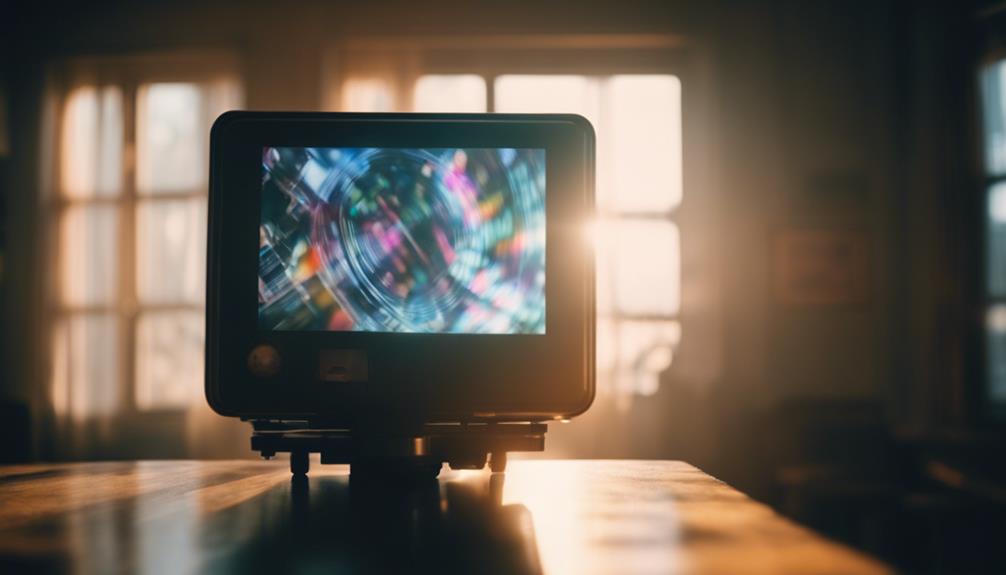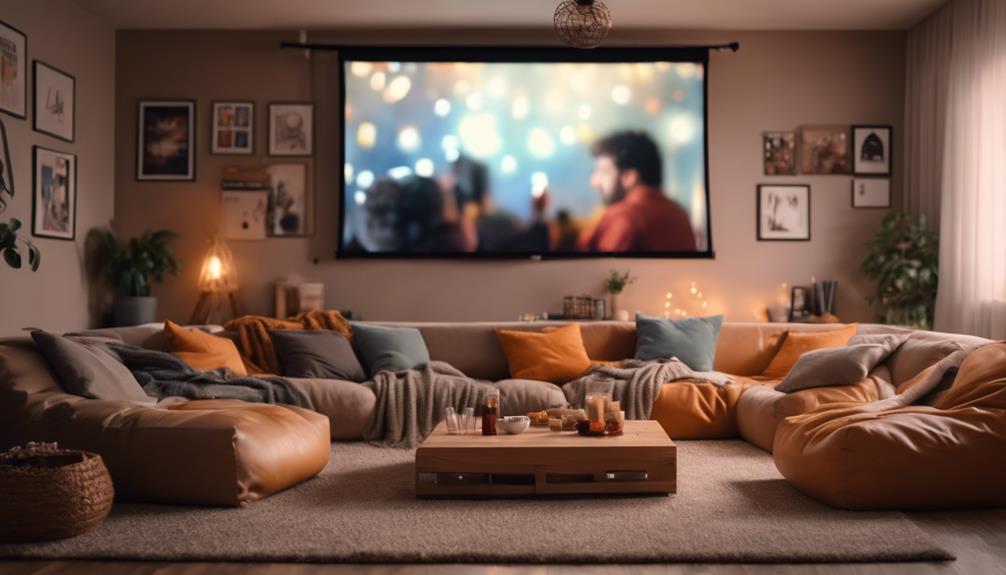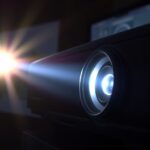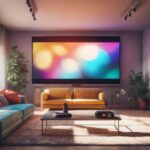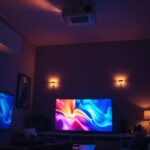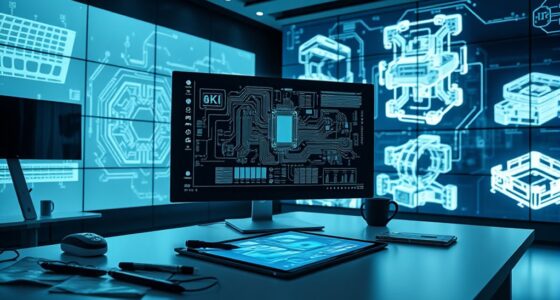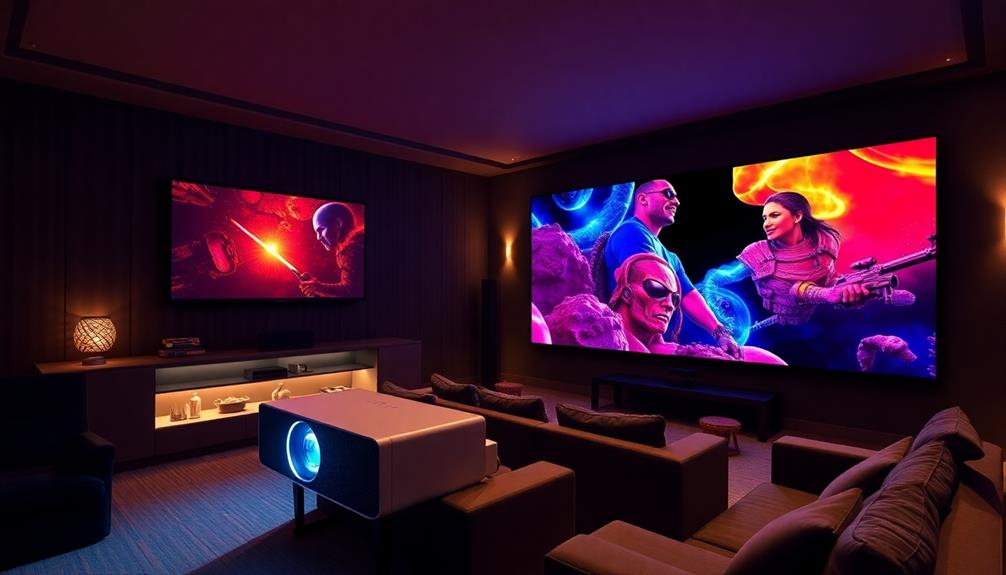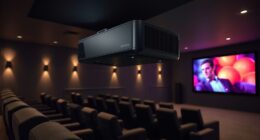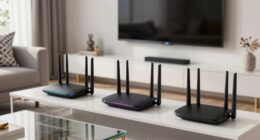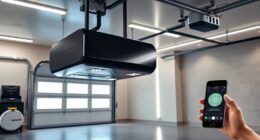Ambient light can greatly affect your projector's performance and image quality. In bright environments, you'll notice washed-out images and reduced visibility, making it hard to enjoy your content. To combat this, choose a projector with at least 2000 ANSI lumens for bright rooms, or 1000-1500 ANSI lumens for moderate light. Specialty screens, like ambient light rejecting (ALR) screens, can also enhance image quality. By understanding your room's lighting and selecting accordingly, you can improve your viewing experience. Stick around to discover more tips and insights into optimizing your projector setup.
Key Takeaways
- Ambient light significantly reduces projector image quality, leading to washed-out visuals and decreased visibility.
- Projectors with higher ANSI lumens (2000+) are essential for bright environments to maintain image clarity.
- Specialty ambient light rejecting (ALR) screens can enhance projection quality in challenging lighting conditions.
- Brightness levels needed vary by setting; 1000-1500 ANSI lumens work well in moderate light environments.
Understanding Ambient Light
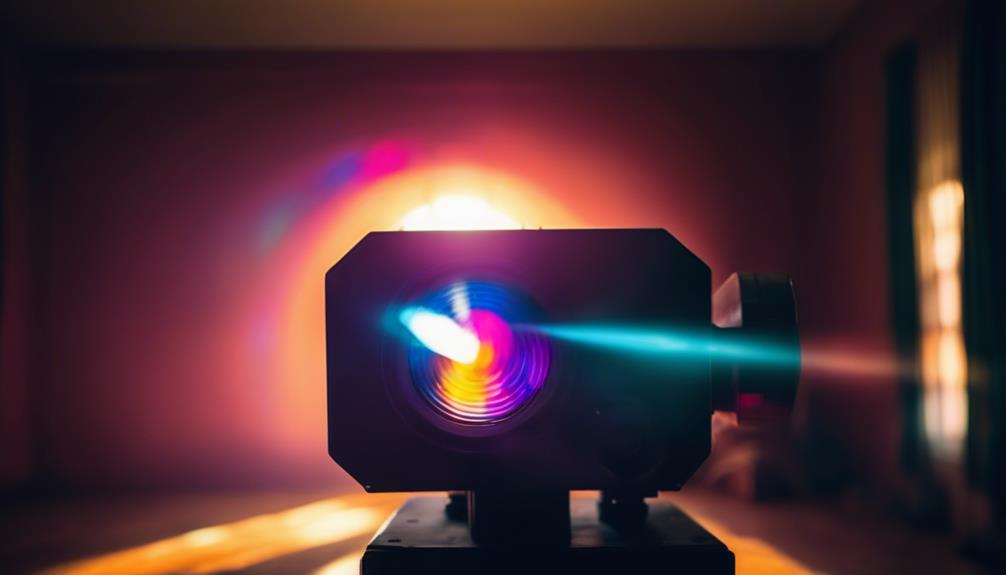
Understanding ambient light is crucial because it directly influences how well your projector performs in different settings. Ambient light includes any existing illumination, such as natural daylight from windows or artificial lighting, which can wash out your projected images.
To counteract this, you'll need to think about projector brightness, often measured in ANSI lumens. For brighter environments, projectors with at least 2000 ANSI lumens are recommended to maintain image quality.
When you're evaluating your space, keep in mind the viewing angle as well; the more ambient light in the room, the more you'll notice a decline in clarity and color vibrancy. Light-colored walls and surfaces can exacerbate this issue, making it essential to manage the light sources around you.
Controlling ambient light can be tricky in typical home environments, so using specialty projection screens designed for these conditions can greatly enhance your viewing experience. These screens can help improve image quality, even when faced with competing light sources, allowing you to enjoy crisp, clear visuals regardless of your setup.
Choosing the Right Projector
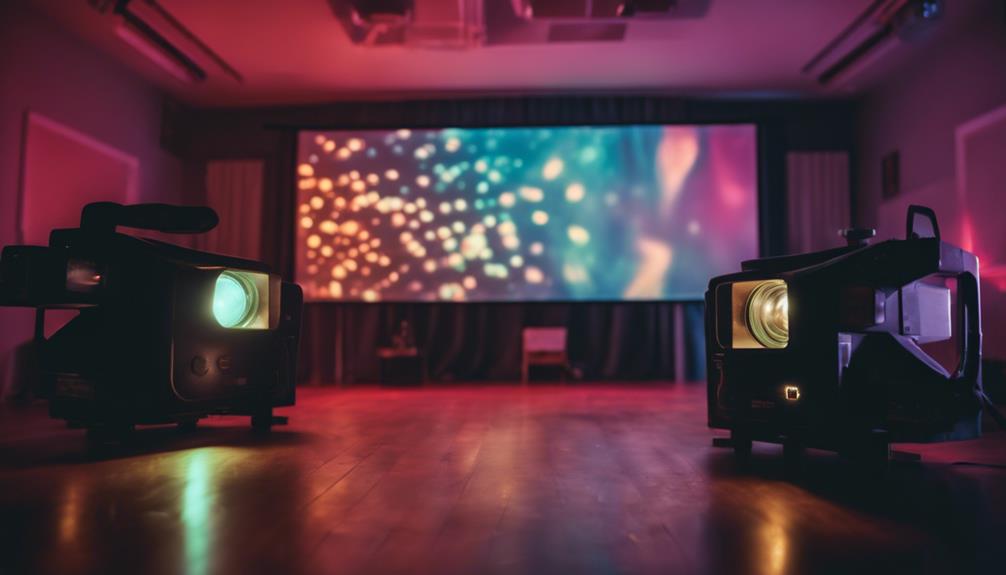
When you're choosing a projector, think about the ambient light in your space.
Projectors with higher ANSI lumens are essential for bright environments to keep your images sharp and vibrant.
Understanding your needs—like screen size and purpose—will guide you in selecting the right brightness level for your setup.
Ambient Light Considerations
Choosing the right projector for your space hinges on the ambient light conditions, so it's crucial to assess how bright or dim the environment is before making a decision.
In brightly lit rooms, you'll want projectors with a brightness rating of 2000 ANSI lumens or more. This guarantees clear visibility and prevents washed-out images on your projector screens.
If your space has moderate ambient light, projectors with a lumen output between 1000 to 1500 ANSI lumens typically deliver a good viewing experience, balancing brightness with image quality.
However, in low light settings, you can opt for projectors with lower lumens, as the reduced light interference allows for better image clarity and color accuracy.
Consider your purpose of use; for business presentations where ambient light is often unavoidable, projectors with 3000 lumens or more are ideal to maintain visibility.
Additionally, evaluate factors like window placement and artificial lighting in your room to determine which projector type will suit your ambient light conditions best.
Your choice can greatly impact your overall viewing experience, so take the time to match the projector to your environment.
Brightness Requirements Explained
Selecting the right brightness level for your projector is crucial to achieving the best image quality in your specific environment.
In spaces with strong ambient light, you'll want a projector that offers at least 2000 ANSI lumens. This guarantees clear, vibrant images without any washout, enhancing your viewing experience.
If you're in a moderately lit room, look for projectors with brightness ratings between 1000 to 1500 ANSI lumens; this range typically balances visibility and color accuracy.
For home theaters, particularly in darker settings, aim for projectors around 1500 to 2000 ANSI lumens to maintain ideal image quality and detail.
If you plan to use your projector for business presentations in brightly lit rooms, you should consider models with a brightness of 3000 ANSI lumens or more. This level effectively combats glare from ambient light sources.
Projector Technology and Features
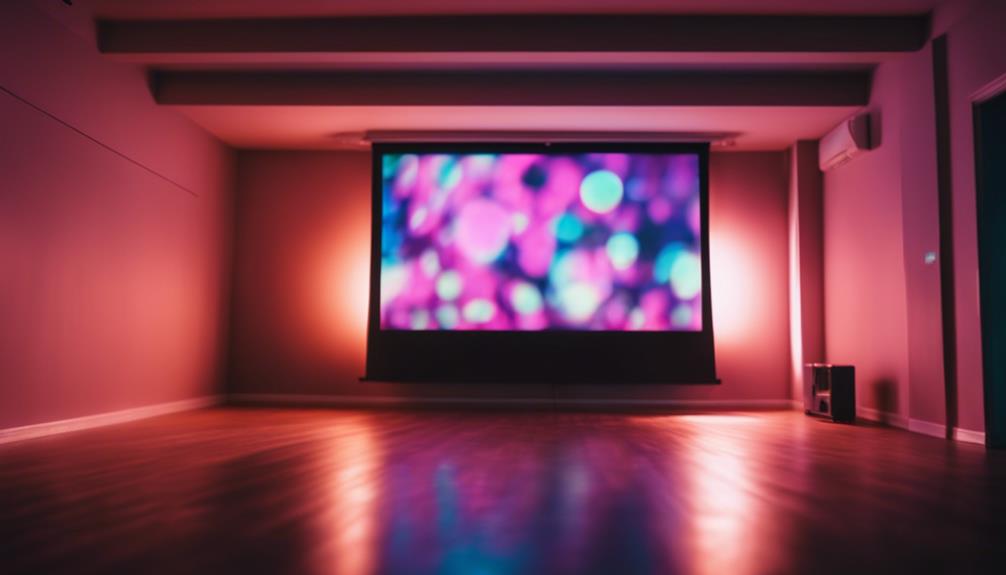
Projector technology continually evolves, offering features like high brightness and true 4K resolution that enhance your viewing experience, even in challenging lighting conditions.
With advancements in projector brightness, you can enjoy vibrant, clear projected images despite ambient light interference. For instance, models like the XGIMI AURA boast 1800 ISO lumens, which greatly improves visibility in bright environments.
To help you choose the right projector for your needs, consider these key features:
- True 4K Technology: With 8.3 million pixels, this technology provides detailed images, making your viewing experience immersive.
- High ANSI Lumens: A minimum of 2000 ANSI lumens is recommended for ideal performance in environments with strong ambient light.
- Ambient Light Rejecting Screens: These screens enhance image quality by minimizing the impact of surrounding light, allowing for a clearer projected image.
Adapting to Light Conditions
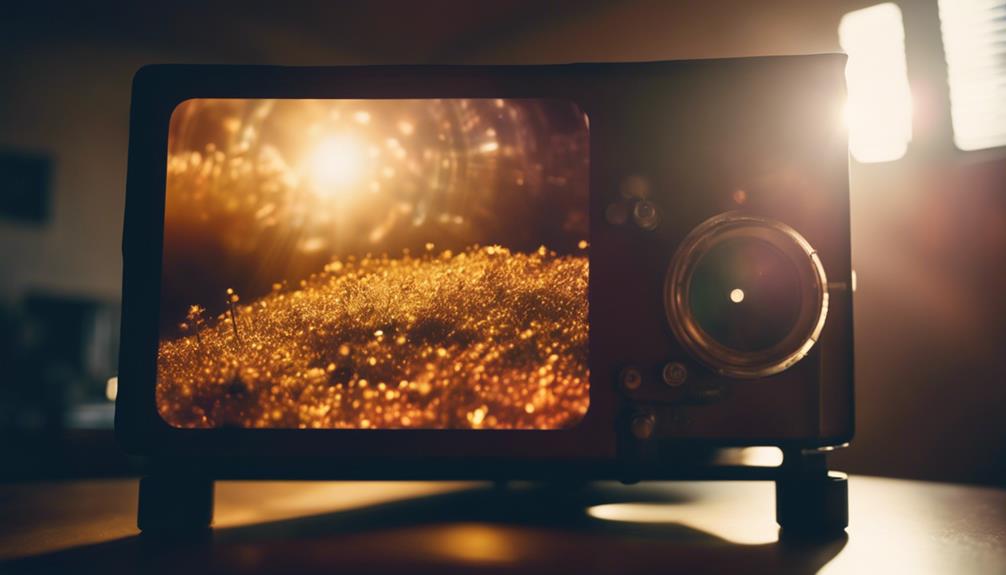
Adapting to different light conditions is essential for achieving the best possible image quality from your projector. The right projector brightness is vital, especially in environments with varying ambient light. Here's a quick reference table to help you understand the requirements based on light conditions:
| Ambient Light Conditions | Recommended Brightness (ANSI Lumens) | Ideal Solutions |
|---|---|---|
| Strong Light | 2000+ | High-brightness projectors, ALR screens |
| Moderate Light | 1000 – 1500 | Mid-range projectors |
| Low Light | 500 – 1000 | Standard projectors |
| Home Theater | 1000+ | ALR screens |
| Conference Rooms | 1500+ | True 4K projectors, ALR screens |
Choosing the right projector technology, like True 4K or ALPD, can enhance your image quality in different light conditions. Additionally, using ambient light-rejecting (ALR) screens can markedly improve your viewing experience by absorbing unwanted light and enhancing contrast. Adjusting the projection angle and screen positioning is also vital in high ambient light, ensuring peak image quality and a satisfying experience.
Recommended Projector Models
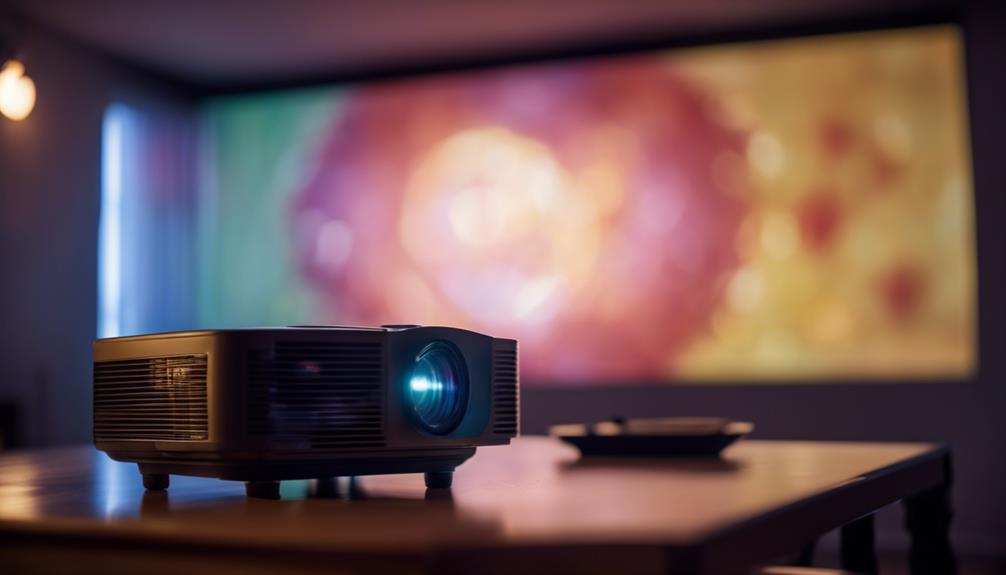
Finding the right projector model can greatly enhance your viewing experience, especially when considering varying ambient light conditions. Choosing a projector that matches your environment is essential for achieving the best results on your projector screen.
Here are three recommended models that excel in different lighting situations:
- XGIMI AURA – With a remarkable 1800 ISO lumens, this projector is perfect for strong ambient light. It guarantees clear, bright images that are easy to project onto your screen without compromising quality.
- XGIMI HORIZON Pro – Priced at $1,099.99, this model features 1500 ISO lumens, making it suitable for moderate ambient light conditions. It balances high brightness with performance, giving you a satisfying viewing experience.
- XGIMI HALO+ – For those who love outdoor movie nights, this projector is designed for high ambient light environments. Its bright performance makes it ideal for projecting visuals outdoors, assuring you won't miss a moment.
Each of these projectors offers unique benefits for different settings, helping you enjoy your favorite movies or presentations, regardless of ambient light.
Importance of Brightness

Brightness plays an essential role in ensuring your visuals stand out, especially in environments where ambient light can easily wash out images. The effectiveness of your projector hinges on its brightness, measured in lumens.
For bright spaces, you'll want a projector with at least 2000 ANSI lumens to counteract ambient light effectively. In darker settings, projectors with 1000-1500 lumens typically suffice.
When you're aiming for peak performance, especially for business presentations, consider projectors with 3000 lumens or more. Insufficient brightness can lead to washed-out images and poor image clarity, compromising your overall viewing experience.
Higher lumens not only enhance the visibility of your content but also improve color accuracy and detail, making your visuals more engaging.
Frequently Asked Questions
What Effect Does Ambient Lighting Have?
Ambient lighting affects how you perceive images, often washing them out and making details hard to see. It can create a less enjoyable viewing experience, especially in bright environments where clarity and color accuracy are compromised.
Is the Ambient Light Rejecting Screen Worth It?
Yes, an ambient light rejecting screen's worth it! You'll enjoy clearer, more vibrant images even in bright rooms. It enhances your viewing experience, reduces eye strain, and makes movie nights or presentations more enjoyable overall.
Does Brightness Matter on a Projector?
Yes, brightness matters on a projector. Higher lumens guarantee clear, vibrant images, especially in well-lit environments. If you want to avoid washed-out visuals, opt for a projector with sufficient brightness for your setting.
What Is the Difference Between Ambient Light Rejecting Screen and Projector Screen?
When you compare an ambient light rejecting screen to a standard projector screen, you'll notice the ALR screen skillfully manages light, ensuring vibrant visuals while the standard screen often struggles in bright environments, resulting in dull images.
Conclusion
In the grand tapestry of projection, ambient light plays a subtle but significant role.
By choosing the right projector and adapting to your environment, you can transform any space into an enthralling visual experience.
Remember, it's not just about brightness; it's about embracing the light around you.
So, as you commence your journey of discovery, keep in mind that even the softest glow can illuminate the path to a more vibrant presentation.
